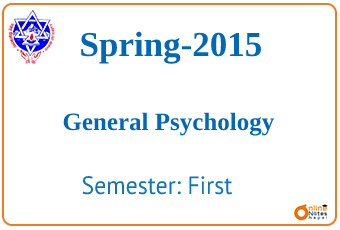Published by: sadikshya
Published date: 22 Jun 2021

This is the question set along with answers of General Psychology Spring 2015, for the first semester which was taken by Pokhara University.
POKHARA UNIVERSITY – General Psychology Spring 2015
Level: Bachelor Semester: Spring Year:2015
Programme: BBA/BBA-BI/BCIS/BHCM/BBA-TT Full Marks: 100
Course: General Psychology, Fall 2015 Pass Marks: 45
Time: 3 hrs
Section “A”
Very Short Answer Questions
Pokhara University
| Section “A”
Very Short Answer Questions Attempt all the questions. |
10×2 |
|
| 1. | State the goal of psychology. | |
| 2. | What is nerve impulse? | |
| 3. | Specify the internally caused behaviour? | |
| 4. | What is reinforcement? | |
| 5. | Point out the cause of forgetting? | |
| 6. | What are the steps of problem-solving thinking? | |
| 7. | Who are the mentally retarded people? | |
| 8. | Differentiate between displayed and felt emotions. | |
| 9. | Define personality. | |
| 10. | State in brief the consequences of stress.
|
|
|
Section “B” Descriptive Answer Questions Attempt any six questions |
6×10 |
|
| 11. | Human behaviour can be studied in laboratory condition. Describe with the help of the experimental method. | |
| 12. | How is information processed in memory? Explain with the help of the Information Processing Model. | |
| 13. | Describe the structure and functions of the neuron. | |
| 14. | What is perception? Explain the laws of grouping. | |
| 15. | Discuss the role of heredity and the role of the environment in determining intelligence with its suitable example. | |
| 16. | What is the projective test? Distinguish between Thematic Apperception Test and Rorschach Inkblot Test. | |
| 17. | Explain motivation with the help of expectancy theory and equity theory. | |
|
18. |
Section “C”
Case Analysis Read the case situation given below and answer the questions that follow. John B. Watson and Rosalie Rayner showed how conditioning could be used on a human infant. The study led to ethical questions on research with humans. From such research, Watson concluded that there are only a few instinctive reflexes in humans, among them, sucking, reaching, and grasping. In addition, infants have three innate emotional responses to stimuli: fear at hearing a loud sound or at suddenly being dropped; rage when an arm or head movements are forcibly restrained; and love when stroked, rocked, gently patted, and the like.
Watson and Rayner hypothesized that most human behaviours and emotional reactions are built up of conditioned responses – When an emotionally exciting object stimulates the subject simultaneously with an object not emotionally exciting, the latter object may in time arouse the same emotional reaction as the former object.
Watson and Rayner presented Albert (a well-adjusted 9-month-old) with many objects, including a rat, blocks, a rabbit, a dog, a monkey, masks with and without hair, cotton, wool, and burning newspapers. Albert showed no fear of any of these objects—they were all neutral stimuli for the fear response.
Watson and Rayner decided that, when Albert was 11 months old, they would attempt to condition him to fear rats. They began by placing a furry white rat in front of him. Albert would reach out to touch it, and each time he did, one of Watson’s assistants would strike a metal bar with a hammer behind Albert. The first time the metal bar was struck, Albert fell forward and buried his head in a pillow. The next time he reached for the rat and the bar was struck, Albert began to whimper. The noise, the unconditioned stimulus, brought about a naturally unconditioned response, fear. After only a few such pairings, the rat became a conditioned stimulus that elicited a conditioned response, fear.
Five days after Watson and Rayner conditioned Albert to fear rats, they presented him with blocks, a rabbit, a rat, and a dog, each alone. They also showed him a number of other stimuli, including a Santa Claus mask. Albert reacted fearfully to all but the blocks. His conditioned fear response generalized to include the rabbit and all of the white furry objects he was shown, but not to any dissimilar toys.
One of Watson’s students, Mary Cover Jones (1924, 1974), developed an extinction procedure called counterconditioning to reduce people’s existing fears. Peter was a boy who was extremely fearful of rabbits. Jones helped Peter eliminate his fear by pairing the feared object (the rabbit) with pleasant experiences, such as eating ice cream or receiving special attention.
Questions: a) Did the results of Watson and Rayner’s experiment support their hypothesis? Explain. b) How did Albert’s response become generalized? c) How were the principles of classical conditioning used to reduce Peter’s fear of rabbits? d) How does classical conditioning differ from operant conditioning? |